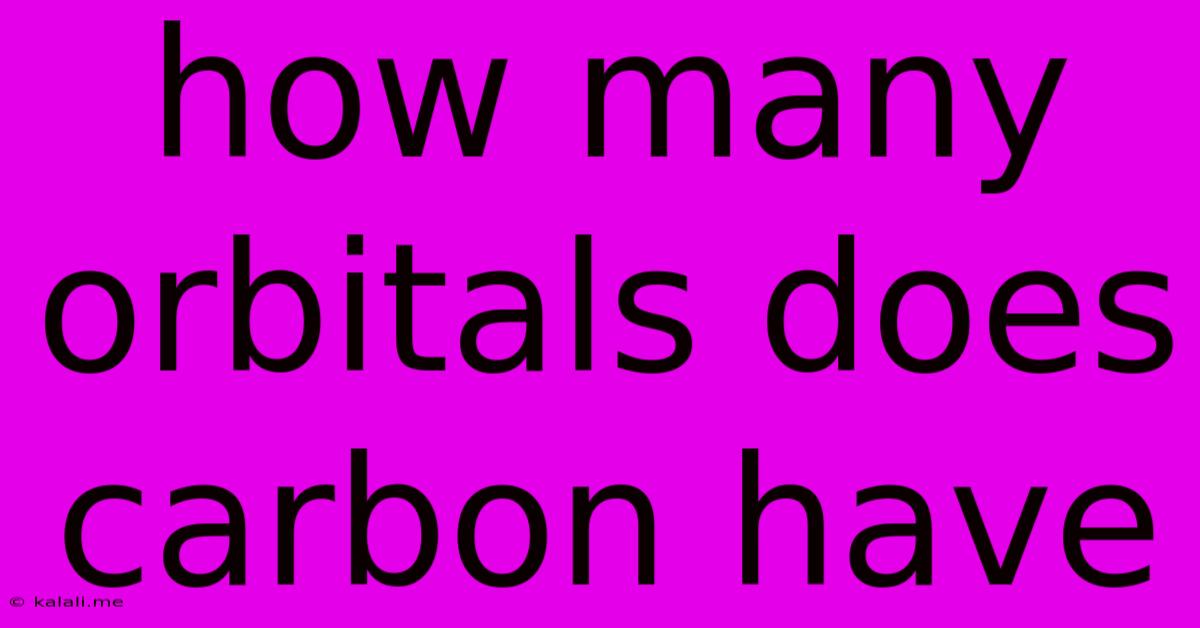How Many Orbitals Does Carbon Have
Kalali
May 28, 2025 · 3 min read

Table of Contents
How Many Orbitals Does Carbon Have? Understanding Carbon's Electron Configuration
Carbon, the backbone of organic chemistry and a fundamental element in life, possesses a fascinating electron configuration that dictates its remarkable bonding capabilities. Understanding how many orbitals carbon has is key to grasping its reactivity and the vast diversity of molecules it forms. This article will delve into the specifics of carbon's electron configuration and explain the number of orbitals it possesses.
Carbon's Electron Configuration and Orbitals:
Carbon's atomic number is 6, meaning it has six protons and six electrons. These electrons fill atomic orbitals according to the Aufbau principle and Hund's rule. The electron configuration of a neutral carbon atom is 1s²2s²2p². Let's break this down:
-
1s²: This signifies that the first energy level (n=1) contains a single s orbital filled with two electrons. s orbitals are spherically shaped.
-
2s²: The second energy level (n=2) also has an s orbital, which is again filled with two electrons.
-
2p²: The second energy level also contains three p orbitals (px, py, pz). These orbitals are dumbbell-shaped and oriented along the x, y, and z axes. In carbon, only two of these three 2p orbitals are occupied, each with a single electron. This leaves one 2p orbital empty.
Therefore, a carbon atom has a total of five orbitals: one 1s orbital, one 2s orbital, and three 2p orbitals.
Understanding Orbital Occupancy and Valence Electrons
The outermost electrons, located in the highest energy level, are called valence electrons. In carbon, these are the four electrons in the 2s and 2p orbitals. These valence electrons are crucial for determining carbon's chemical behavior and bonding characteristics. Carbon's four valence electrons enable it to form four strong covalent bonds, leading to the vast array of organic molecules.
Hybrid Orbitals: A Deeper Dive
While the simple electron configuration explains the number of orbitals, the story is more complex when considering bonding. Carbon's ability to form four bonds isn't fully explained by its simple s and p orbitals. To better understand carbon's tetrahedral bonding geometry (like in methane, CH₄), the concept of hybrid orbitals is introduced.
In many carbon compounds, the 2s and 2p orbitals hybridize to form four equivalent sp³ orbitals. This hybridization creates four identical orbitals that point towards the corners of a tetrahedron. This is a crucial aspect of carbon's chemistry, allowing it to form stable and strong bonds with other atoms in various geometries. However, it's important to remember that the number of orbitals remains five; hybridization simply changes their shape and energy levels.
Conclusion
In summary, a carbon atom has a total of five atomic orbitals: one 1s, one 2s, and three 2p orbitals. Its four valence electrons, residing in the 2s and 2p orbitals, are responsible for its remarkable bonding versatility. Understanding carbon's electron configuration and orbital hybridization is fundamental to understanding its pivotal role in organic chemistry and the vast diversity of organic molecules found in nature and created by humans.
Latest Posts
Latest Posts
-
How To Fill A Hole In Wood Floor
May 30, 2025
-
By Signing This Document You Agree
May 30, 2025
-
How To Turn World Border Minecraft Off
May 30, 2025
-
What Do You Call A Person
May 30, 2025
-
How To Treat Oil Spill On Disk Brake
May 30, 2025
Related Post
Thank you for visiting our website which covers about How Many Orbitals Does Carbon Have . We hope the information provided has been useful to you. Feel free to contact us if you have any questions or need further assistance. See you next time and don't miss to bookmark.